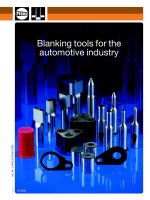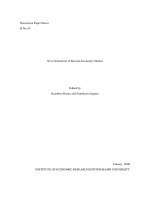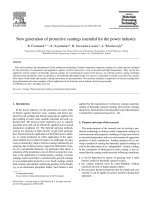new generation of protective coatings intended for the power industry
Bạn đang xem bản rút gọn của tài liệu. Xem và tải ngay bản đầy đủ của tài liệu tại đây (588.41 KB, 6 trang )
Journal of Materials Processing Technology 164–165 (2005) 850–855
New generation of protective coatings intended for the power industry
B. Formanek
a, ∗
, K. Szyma
´
nski
a
, B. Szczucka-Lasota
a
, A. Włodarczyk
b
a
Department of Materials Science and Engineering, Silesian University of Technology, Krasi´nskiego 8, 40-019 Katowice, Poland
b
RAFAKO SA Boiler Engineering Company, ul. Ł˛akowa 33, 47-400 Racib´orz, Poland
Abstract
This article presents the fundamentals of the production technology of multi-component composite coatings of a zonal structure designed
for the protection of components and appliances against corrosive and erosive wear at elevated and high temperatures. They can be also
applied to seal the surfaces of thermally sprayed coatings. In a technological variant of the process, an external ceramic coating containing
aluminium and chromium oxides was produced. An aluminium phosphate binder was used as a component of ceramic seal and of the coating.
Flow charts of the binder and ceramic coatings fabrication are presented here. The structure and phase composition of selected coatings have
been determined and some examples of their application in the domestic power industry have been presented.
© 2005 Elsevier B.V. All rights reserved.
Keywords: Coatings; Thermal spraying; Sealing; Aluminium phosphate binder
1. Introduction
In the power industry, for the protection of water walls
of boilers against intensive wear, coatings and layers pro-
duced by pad welding and thermal spraying are applied. For
pad welding of water walls, metallic materials are used, e.g.
Inconel 625. The process itself, expensive as it is, requires
specialist tools and can be effectively applied only in actual
production conditions [1]. The thermal spraying methods,
such as arc spraying or high velocity oxygen fuel spraying,
have found numerous applications in the Polish power indus-
try. A certain limitation of wider application of the super-
sonic method are its relatively high costs (although, in many
cases economically viable), whereas coatings obtained by arc
spraying, due to their porosity, require the fabrication of lay-
ers of a considerable thickness. An alternative that allows a
reduction of the production costs of effective protective coat-
ings is the application of metal/ceramic coatings. Ceramic
coatings can be used either to seal thermally sprayed coatings
or as an independent protective cover. Such coatings contain
both ceramic and metallic reinforcing particles in the binder,
e.g. in an aluminium phosphate binder. Such binder is also
∗
Corresponding author.
E-mail address: (B. Formanek).
applied for the manufacture of refractory ceramic materials,
sealing of thermally sprayed coatings and ceramic coatings
themselves.Informationconcerningthis issueintheliterature
is limited for commercial reasons [1–12].
2. Purpose and scope of the research
The main purpose of the research was to develop a pro-
duction technology to obtain a multi-component coating of a
zonal structure and properties enabling its long-term work at
an elevated temperature and in an environment of aggressive
products of fuels combustion. Another purpose was to de-
velop a method of sealing the thermally sprayed coatings as
well as the fabrication of an “independent” ceramic coating.
In the conception of fabrication of such coating, it was as-
sumed that the coating would meet the following conditions:
• it can be deposited by means of spraying onto a sand-
blasted, etched or thermally sprayed surface,
• the coating material must be water-dilatable, without
chemical solvents or liquid organic matter,
• the necessary thermal treatment must be simple and con-
venient; it can be applied in power facilities during their
operation.
0924-0136/$ – see front matter © 2005 Elsevier B.V. All rights reserved.
doi:10.1016/j.jmatprotec.2005.02.098
B. Formanek et al. / Journal of Materials Processing Technology 164–165 (2005) 850–855 851
It was assumed that based on the inorganic aluminium
phosphate binder, a coating material could be fabricated to
be used for the modification of the thermally sprayed coat-
ings surface structure, the material being an element that
would bind the components of the ceramic coating. Fur-
thermore, it was assumed that the phosphate binder applied
in the process of coatings’ sealing would form a passive
surface and next, in consequence of the phase composition
and volume change during thermal treatment, it would seal
the porosity of the coatings resulting from the technologi-
cal process. The scope of the research presented covers part
of the research carried out under earlier works of the au-
thors.
The scope of the research encompassed:
• the development of a material and technological concep-
tion of the fabrication of sealing and multi-component
composite coatings,
• the selection of appropriate components and technological
processes to fabricate the material,
• the development of the conditions and technological pa-
rameters for the production of al aluminium phosphate
binder and coating material,
• the determination of the structure and phase composition
of the binder and the coatings.
Currently, wide research is conducted on utilitarian prop-
erties and performance of the coatings. In order to meet the
targetandcoverthescopeoftheresearch,thefollowingmeth-
ods were applied:
• light microscopy, to determine the composite coatings’
structure (Reichert MFZ),
• scanning microscopy and EDX analysis, to evaluate the
structure and chemical composition of the materials used,
• X-ray radiography analysis by means of a Philips X-Pert
diffractometer, to determine the phase composition of the
binder.
The metallic coatings were thermally sprayed by arc
(Smart ARC) and HVOF spraying methods (JET Kote II, Di-
amond Jet 2600), whereas the ceramic coating was sprayed
by classical pneumatic method.
Fig. 1. Scheme of the aluminium phosphate binder synthesis.
Fig. 2. Scheme of the ceramic sealing or coating preparation.
3. Results and discussion
The first stage of the research carried out was the deter-
mination of the factors that influence the properties of the
aluminium phosphate binder. The applied technological pro-
cedures for binder production are shown in Fig. 1.
The binder produced as a result of the above procedure
constitutes one of the fundamental components of the coat-
ing material to be obtained. After a number of technological
operations presented in Fig. 2, a finished coating material
is obtained. It can be either used to seal thermally sprayed
coatings or serve as an independent cover.
The coating material after its application requires ther-
mal treatment in order to remove water from it. During the
thermal treatment, a transformation of hydrated phosphates
to a hexagonal and regular lattice Al(PO
4
)
3
was found as
well as a transformation of aluminium phosphate AlPO
4
Table 1
Phase composition of a modified aluminium phosphate binder in the tem-
perature range 293–1073 K
Temperature (K) Phase composition
353 Amorphous structure AlH
3
(PO
4
)
2
·3H
2
O
393 Amorphous structure AlH
3
(PO
4
)
2
·3H
2
O Al(H
2
PO
4
)
3
hexagonal
473 Al(H
2
PO
4
)
3
hexagonal
523 AlPO
4
tetragonal, AlH
2
P
3
O
10
·2H
2
O
683 Al(PO
3
)
3
hexagonal
,
AlH
2
P
3
O
10
773 Al(PO
3
)
3
,Al
2
P
6
O
18
873 Al(PO
3
)
3
,Al
2
P
6
O
18
, AlPO
4
tetragonal
1023 Rhombic AlPO
4
, Al(PO
3
)
3
852 B. Formanek et al. / Journal of Materials Processing Technology 164–165 (2005) 850–855
Fig. 3. X-ray diffraction pattern of ceramic coatings with Cr
2
O
3
.
from a tetragonal lattice to a rhombohedron one. Changes
of the binder phase composition during soaking are shown
in Table 1. The thermal treatment process is not compli-
cated and can be conducted under actual operating condi-
tions.
The aluminium phosphate binder, after adding special ce-
ramic fillers, which give different colours to the mixture, can
be applied for the production of ceramic coatings. Two types
of fillers were tested, one with a higher content of Al
2
O
3
and
the other, Cr
2
O
3
.
Fig. 4. Structures and chemical compositions of coatings: (a–b) phosphate binder – ceramic and metal particles; (c–e) phosphate binder – oxides.
B. Formanek et al. / Journal of Materials Processing Technology 164–165 (2005) 850–855 853
Fig. 5. Morphology of coatings after 24 h oxidation test: (a) Fe
x
Al
y
–Al
2
O
3
,
(b) Fe
x
Al
y
–Al
2
O
3
with phosphate seal.
The X-ray diffraction pattern of ceramic coating is pre-
sented in Fig. 3.
Ceramic coatings were also deposited on thermally
sprayed coatings. The laboratory corrosion tests have corrob-
oratedthesignificantincrease of corrosionresistanceafterthe
application of ceramic sealing (Fig. 4).
Fig. 6. Morphology of Fe
x
Al
y
–Al
2
O
3
coatings after 24 h corrosion test.
Fig. 7. Morphology of Fe
x
Al
y
–Al
2
O
3
coating with phosphateseal after 24h
corrosion test.
The morphology of composite coating with and without
phosphate sealing after oxidation tests is presented in Fig. 5.
The sealed coatings have better protective properties compa-
rable to the coatings without phosphate seal.
The corrosion products on the surface of the coatings
with phosphate seal after 48 h oxidation test contain only
the Al
2
O
3
phase. The corrosion products structure of there
coatings is nodular (Fig. 5(b)) The whiskers structure of
corrosion products after 48 h exposure time can be ob-
served only on the coatings without phosphate seal and
they corrosive layer contain the iron and aluminium ox-
ides.
The sealing process increases the corrosion resistance of
coatings in air as well as in aggressive environment. The
morphology after corrosion test in gases contains chlorine
and sulphur is presented in Figs. 6 and 7. The layer of corro-
sion products on the coatings without seal contains sulphides
and iron and aluminium oxides. The homogenous structure
of phosphate phase can be observed only on the sealed coat-
ings (Fig. 7). The results of this research are presented in
publications [8–12].
4. Conclusion
The aluminium phosphate binder after thermal treatment
forms effective sealing and it is a component of ceramic coat-
ings applied for the modification of surfaces of thermally
sprayed coatings. The chemical and phase compositions as
well as the properties of the sealing and coatings ensure their
high protective properties at elevated temperatures and in
complex aggressive corrosion atmospheres. Owing to a frac-
tion of hard phases, e.g. Al
2
O
3
or Cr
2
O
3
, in their chemical
composition, ceramic coatings are also characterized by re-
sistance to abrasive wear. They can work at temperatures of
up to 1900
◦
C. They are resistant to thermal shocks and have
854 B. Formanek et al. / Journal of Materials Processing Technology 164–165 (2005) 850–855
Fig.8. Ceramic coatingof typeBsprayed ona selectedareaof water wall:(a)
coating sprayed by pneumatic system, (b) measurement of coating’s thick-
ness after heat treatment, (c) screen with a coating installed inside the water
wall.
Fig. 9. Ceramic coating of type A on the tube in a pulverized-fuel boiler: (a)
coating sprayed by pneumatic system, (b–d) coatings after 1 year exploita-
tion.
very high emissivity (at a temperature of above 800
◦
C for
technically useful wave lengths).
The developed material and technological conception,
which takes into account a modification of thermally sprayed
coatings’ surfaces and the fabrication of layered multi-
component coatings, was applied to protect the surface of
power boiler water walls. Figs. 8 and 9 present examples
of coatings applied for the protection of water walls of
pulverized-fuel power boilers.
The developed variants of the production technology of
coatings of the required utilitarian properties take into ac-
count the complex conditions of their operation in the power
industry. The application of metal/ceramic or ceramic com-
posite coatings can be very wide, owing to their properties.
They can be applied as:
• surface protection against corrosive wear, e.g. of ducts,
electrostaticprecipitators,chimneysandotherinstallations
in powerplants, incinerating plants and flue gas desulphur-
ization installations,
B. Formanek et al. / Journal of Materials Processing Technology 164–165 (2005) 850–855 855
• in heat consuming and processing installations; owing to
an increase of emissivity, the heat flow effectiveness im-
proves with a simultaneous reduction of the working sur-
face temperature.
References
[1] A. Włodarczyk, T. Wala, B. Formanek, K. Szyma
´
nski, Ograniczenie
korozji wysokotemperaturowej w kotłach opalanych w
˛
eglem kamien-
nym w działaniach RAFAKO S.A. – Konferencja Problemy Spalania
w kotłach energetycznych Zakopane 27–28 Listopad, 2003.
[2] W.D. Knigery, J. Am. Ceram. Soc. (33) (1950) s.454.
[3] J.E. Cassidy, Am. Ceram. Soc. Bull. (56) (1977) s.640.
[4] J.D. Birchell, N.M. Alford, K. Kendal, J. Mater. Sci. Lett. (6) (1987)
s.1456.
[5] J.M. Chion, D.D.L. Chung, J. Mater. Sci. (28) (1993) s.1435.
[6] M. Vipola, S. Ahmaniemi, J. Ker
¨
anen, P. Vuoristo, T. Lepist
¨
o, T.
M
¨
antyl
¨
a, E. Olsson, Aluminium phosphate sealed alumina coating:
characterization of microstructure, Mater. Sci. Eng. A323 (2002) 1–8.
[7] M. Vipola, J. Vuoristo, P. Vuoristo, T. Lepist
¨
o, T. M
¨
antyl
¨
a, Thermal
analysis of plasma sprayed oxide coating sealed with aluminium
phosphate, J. Eur. Ceram. Soc. 22 (2002) 1937–1940.
[8] B. Formanek, K. Szymanski, B. Szczucka-Lasota, B. Bierska,
Kompozytowe proszki i natryskiwane cieplnie powłoki z os-
now
˛
a NiCr i fazami mi
˛
edzymetalicznymi, Mi
˛
edzyzdroje 2003. str.
617–620, In
˙
zynieria Materiałowa, vol. 6, no. 137, 2003, pp. 617–
620.
[9] B. Szczucka-Lasota, B. Formanek, A. Hernas, L. Pajak, in: L.A.
Dobrzanski (Ed.), Corrosion resistance of composite HVOF sprayed
coatings with FeAl and NiAl intermetallic phases in aggressive en-
vironment, Achievement in Mechanical and Materials Engineering,
2003, pp. 889–894.
[10] B. Szczucka-Lasota, B. Formanek, K. Szymanski, B. Bier-
ska, in: L.A. Dobrzanski (Ed.), Oxidation of thermally sprayed
coatings with FeAl intermetallic matrix, Zakopane, Achieve-
ment in Mechanical and Materials Engineering, 2003, pp. 901–
904.
[11] B. Szczucka-Lasota, B. Formanek, L. Pajak, K. Szymanski, in: L.A.
Dobrzanski (Ed.), Oxidation of HVOF sprayed coatings with NiAl
intermetallic matrix and ceramic phases, Achievement in Mechanical
and Materials Engineering, 2003, pp. 895–900.
[12] B. Formanek, K. Szyma
´
nski, A. Pucka, B. Szczucka-Lasota, B.
Kowalski, A. Włodarczyk, Natryskiwane cieplnie powłoki dla zabez-
pieczenia
´
scian wodnych kotł
´
ow i innych urz
˛
adze
´
n energetycznych,
PIRE 2003.









